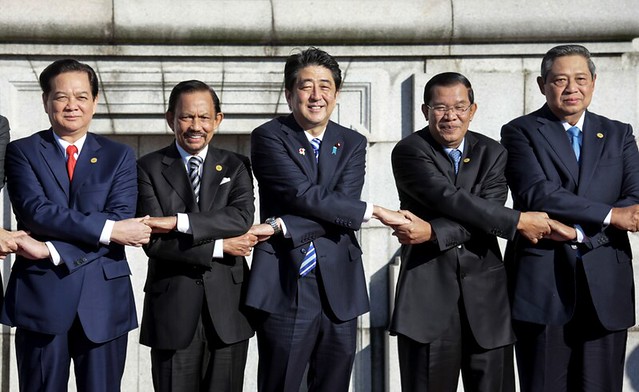
Japanese Prime Minister Shinzo Abe and some ASEAN leaders
Japan has enjoyed amicable relations with the Association of Southeast Asian Nations (ASEAN) since it was granted a Dialogue Partner status in 1977. But like other key partners of ASEAN, Japan has been from time to time constrained by other equally important foreign policy issues that might have obstructed the development in their bilateral relationship, such as its relations with the United States, China and South Korea as well as security issues on the Korean Peninsula.
Such conditions have formed a certain viewpoints of Japan in regards to approaches toward regionalism, and in particular to its relations with ASEAN. Yet, it is imperative to note here that those conditions are not the only determinant factors, which explain the current state of ASEAN-Japanese relations. After all, ASEAN has remained important in Japan’s Asia policy.
Japan’s relations with ASEAN have been solid mainly because there were no outstanding disputes between the two sides, be it political or economic. In retrospect, Japan’s diplomatic activism towards Southeast Asia can be seen in the mid-1960s but was more evident in 1977 following the announcement of the Fukuda Doctrine. While the Fukuda Doctrine has served as the bedrock of Japan’s diplomacy towards Southeast Asia, subsequent leaders of Japan had continued to reinvent new initiatives towards ASEAN so as to be able to catch up with the changing regional environment.
Prime Ministers Ryutaro Hashimoto (1996-1998) and Prime Minister Keizo Obuchi (1998-2000), for example, were active during 1997-98 and took a series of initiatives towards ASEAN now remembered as Asian Monetary Fund (AMF) and Miyazawa initiatives. At the same time, China has emerged as a major factor in the past decades. Despite the tension between the two countries over PM Junichiro Koizumi’s Yasukuni visit and Japan’s attempt to become a permanent member of the UN Security Council, Japan and China worked in harmony in the wake of the 1997 financial crisis and helped greatly to strengthen the ASEAN Plus processes. The creation of ASEAN Plus 6 was probably the first occasion in which Japan and China diverged about the direction in which ASEAN Plus processes should develop.
The proposed creation of the East Asian Community (EAC) apparently unveiled the different approaches taken by Japan and China towards Asian regionalism. First, the changing regional landscape, which includes the rise of China, has been a significant factor behind Japan’s renewed enthusiasm in ASEAN and Asian regionalism. But it must be made clear that Japan’s Asia policy is not to dilute China’s influence on the region. On the contrary, Japan understands the need for the evolution of the regional order. The question is how to make it happen, in what direction and with what principles. Other countries, including Japan, do not want China to impose its rule others. Successive Japanese governments have come to realise the usefulness of the hub role of ASEAN for regional cooperation. Overcoming the Chinese influence has not been an ultimate objective, although keeping the right balance of power has always been in Japan’s interest. And in this process, political alignments and partnerships have proven useful for Japan. As evident, Japan has underlined the ASEAN hub status while continuing to engage China. Ultimately, what matters most to members of the region is rule-making and norm-building.
Second, Japan’s approach toward an EAC is greatly different from that of China. These differences must not be construed as Japan and China adopting different views regarding regionalism. Instead, they expose the extent to which the two countries have taken advantage from regionalism differently to fulfil their national interests vis-à-vis ASEAN. For example, while China prefers closed regionalism as it allows Beijing to better manoeuvre its relations with ASEAN, Japan promotes open regionalism in order to maintain a balance of power in the region.
Third, this situation led to a perception of the existence of a fierce rivalry between Japan and China which has generated both positive and negative repercussions on the region, and specifically on the pace of regionalism. Positively, it has stimulated other regional players to step up their game, for example ASEAN and South Korea. Moreover, it encourages ASEAN to reinforce its own organisation, in the face of the supposed Sino-Japanese competition, by taking a leading role where different opinions persist. Negatively, it could derail regional cooperation efforts. And in reality, member countries may put too much emphasis on defending their national gains rather than those of the region.
Admittedly, although Japan has maintained a strong relationship with ASEAN, their ties have faced several challenges over the years, particularly those stemming from Japan’s Asia policy, such as the decline in Japan’s Official Development Assistance (ODA) and tough economic competition in Southeast Asia. Meanwhile, China-ASEAN official relations commenced only in the mid-1990s. China was accorded full Dialogue Partner status in July 1996 in Jakarta, 19 years after Japan acquired the same status. However, China was the first Dialogue Partner to accede to the Treaty of Amity and Cooperation (TAC) in Southeast Asia at the 7th ASEAN-China Summit in October 2003 in Bali, one year before Japan decided to sign the same document.
Unlike Japan, China has long regarded Southeast Asia as under its influence, both in the historical context (China perceiving itself as the Middle Kingdom and its relations with Southeast Asia through tributary system) and has today attempted to maintain that level of influence through developing closer links with the region. China also wants to erase this negative image, such as being perceived as a military and economic threat, its aggressive policy towards the South China Sea disputes and its influence on some Southeast Asian countries, most notably Cambodia, Laos and Myanmar. China initiated its FTA negotiation with ASEAN in 2002, after realising the usefulness of an earlier Japanese-Singaporean FTA initiated in YEAR. It also signed a Declaration on Code of Conduct in the South China Sea with an aim of maintaining peace and stability in the South China region, as a way to alleviate the region’s threat perception of China.
In parallel, China has firmed up its ties with individual members of ASEAN on a bilateral basis. Thailand became the first country in ASEAN to have concluded a bilateral FTA with China, which came into effect in 2003. China has also begun conducting annual military exercises with Thailand, to emulate the Cobra Gold but in a much smaller scale
It is evident that the level of dynamics between Japan and China has over the years heightened in the region. After the first APT summit in 1997, there had been efforts from all key countries in the region to construct a new platform that would help consolidate an East Asian regionalism. In 2000, ASEAN commenced a feasibility study on the establishment of the EAS. The EAS, with its first meeting in 2005 in Kuala Lumpur, consists of the APT members, plus India, Australia and New Zealand.
The five-year gap between the EAS’s initial idea and its first summit offered an opportunity for Japan to develop its approach of a regional community and claim its ownership. Accordingly, the Japanese government recommended a commemorative summit with all ASEAN members to mark the 30th anniversary of ASEAN-Japan diplomatic relations; it became the first summit between ten ASEAN countries and Japan outside the SEA region. This had increased Japan’s strategic position vis-à-vis ASEAN.
In response, China offered to host the first EAS on Chinese soil as a symbol of its genuine commitment to the East Asian regionalisation process. But it was declined, not only by Japan but also by some ASEAN members who insisted on ASEAN maintaining its centrality in the EAS. Instead, Malaysia played host to the first EAS in 2005, followed by the Philippines in 2006, Singapore in 2007, Thailand in 2009, and Vietnam in 2010. As China’s offer was stalled, Japan came up with a new proposition to co-host the EAS with Malaysia.
Simultaneously, Japan produced its Concept Paper on the EAC in 2004 to elaborate on its vision of Asian regionalism. China immediately rebuffed Japan’s proposition and insisted on allowing a single host of the EAS. Beijing also distributed the Modality Paper in 2005, a Chinese view of an EAC, to counter Japan’s Concept Paper. This undoubtedly put a spotlight on the different approaches toward regionalism between Japan and China even when their action seemed to recognise ASEAN as the chief driver of the regional integration.
*This is the first of a two-part article, continue to read the final part.

Pavin Chachavalpongpun is Associate Professor at Kyoto University’s Centre for Southeast Asian Studies.
Prachatai English is an independent, non-profit news outlet committed to covering underreported issues in Thailand, especially about democratization and human rights, despite pressure from the authorities. Your support will ensure that we stay a professional media source and be able to meet the challenges and deliver in-depth reporting.
• Simple steps to support Prachatai English
1. Bank transfer to account “โครงการหนังสือพิมพ์อินเทอร์เน็ต ประชาไท” or “Prachatai Online Newspaper” 091-0-21689-4, Krungthai Bank
2. Or, Transfer money via Paypal, to e-mail address: [email protected], please leave a comment on the transaction as “For Prachatai English”
